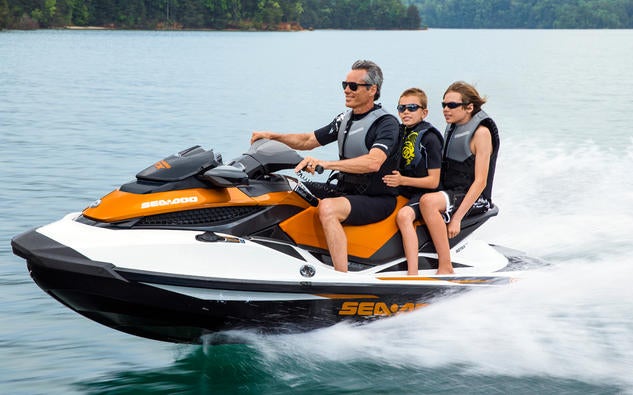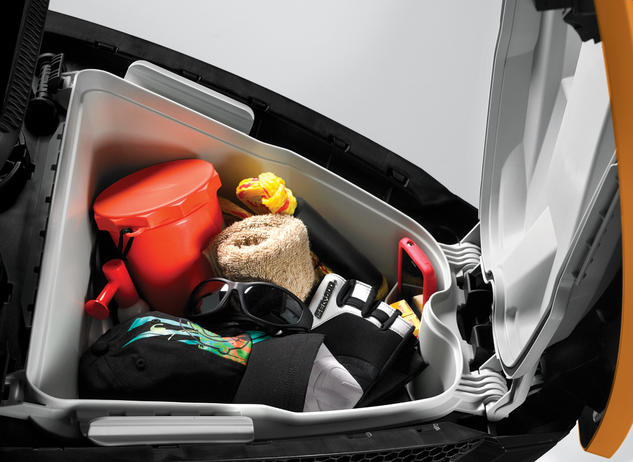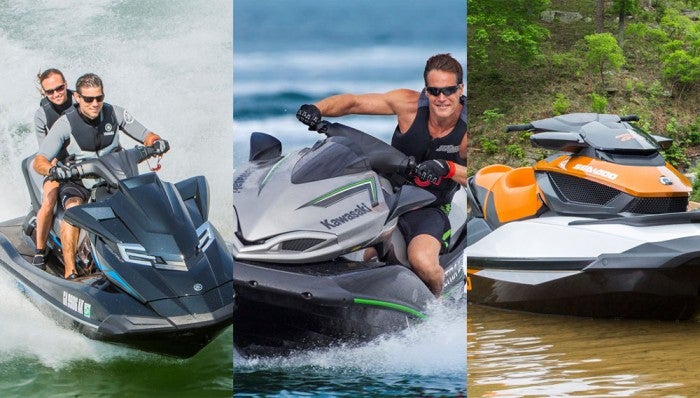2015 Kawasaki Ultra LX vs. Sea-Doo GTX 155 vs. Yamaha FX HO
Flagship hull designs and high-end features at mid-market prices
A lot of attention has been focused in recent years on the extremes in each PWC manufacturer’s lineup. The high-end models, as usual, get their fair share of attention for all their extreme power, handling, and cool features. The low-end, as of late, has gotten almost equal attention as consumers look for a low-cost entry into the sport, or perhaps another reasonably priced toy to add to their arsenal.
It’s that often overlooked middle ground, however, that just may be the true sweet spot in the PWC market. Typically priced between $11,000-$13,000, these boats often share each manufacturer’s flagship hull designs but scale back the power, making them more affordable not only to buy but also more fuel-efficient and economical to run.
How do the offerings from the three manufacturers compare? Let’s take a closer look at three models that nicely fit this description – Kawasaki’s Ultra LX, Sea-Doo’s GTX 155, and Yamaha’s FX HO.
 From left to right: Kawasaki Ultra LX, Sea-Doo GTX 155 and Yamaha FX HO
From left to right: Kawasaki Ultra LX, Sea-Doo GTX 155 and Yamaha FX HOCommon Core
All three models follow a similar path in terms of power, primarily foregoing a supercharger to knock a few dollars off the price tag. Kawasaki shares the same 1,498cc base engine found throughout the Ultra line, and Sea-Doo the identical 1,494cc Rotax. Yamaha boasts the biggest displacement at 1,812cc.
Yamaha Introduces Dual-Lever “RIDE” Controls
How do these displacements translate to speed and acceleration? Suffice it to say that all three models will easily handle any task you throw their way, whether that be taking the crew skiing and wakeboarding, touring three-up, or even lining up against your friends for an informal drag race. In terms of pure top speed, Yamaha holds a decided edge, peaking in the range of 62-63 mph in most of our testing. Kawasaki and Sea-Doo, meanwhile, finish in the mid 50s, with both craft averaging closer to 55 mph.
 Thanks to its larger-displacement engine, the Yamaha FX HO is the quickest craft by a comfortable margin.
Thanks to its larger-displacement engine, the Yamaha FX HO is the quickest craft by a comfortable margin.That’s a significant difference for sure, but rest assured each feels plenty fast on the water. All three enjoy strong acceleration off the bottom end, and each will power through a corner with gusto. Without the addition of a supercharger, however, Yamaha’s displacement pays obvious dividends.
On-Water Attitude
As to handling, we’d argue that all three excel. These are big hulls (Sea-Doo and Yamaha measure in around the 140” mark, Kawasaki just shy of 133”), able to handle anything from glass calm to ocean chop with relative ease and confidence. They also each like to be powered into a turn, and reward the rider with an intuitive, easily handled inside lean.
 Each craft is capable of holding a rider and two passengers, though it’s a bit of a cozy fit.
Each craft is capable of holding a rider and two passengers, though it’s a bit of a cozy fit.And while Yamaha and Sea-Doo are slightly longer, all comfortably fit two riders, and can haul a trio when tasked.
Extra, Extra
Where the three truly show their differences is in terms of features.
Both Sea-Doo and Yamaha truly stand out in 2015 for their implementation of electronic reverse control, and the ability to use that control to also provide stopping/slowing power out on the water. Though each will tout their differences, as a whole they’re quite similar. Each uses a lever adjacent to the left handlebar grip to activate the reverse bucket. When you start each craft, that bucket assumes a position that allows the craft to stay in a neutral mode. Grabbing the throttle allows the boat to move forward, grabbing the reverse allows it to move backward. Each system deserves kudos for the fact that it allows the driver to keep their eyes focused on the water, and not search for a console-mounted lever. Each also deserves praise for the fact that they each rapidly decelerate the boat at speed, whether that’s to avoid an obstacle or just to come to the quickest stop.
 The Kawasaki lacks some of the electronic goodies of the Sea-Doo and Yamaha, but it costs less and is still a capable performer.
The Kawasaki lacks some of the electronic goodies of the Sea-Doo and Yamaha, but it costs less and is still a capable performer.The primary difference between the two systems is that Sea-Doo’s literally electronically shifts between a forward, neutral and reverse mode. With Yamaha, it’s more of a fluid transition between the three, meaning you can rapidly slow and then jump right back on the throttle with no obvious change or hesitation. Yamaha allows for far more thrust in reverse, which can be put to good use. It also, however, takes a little more care in tight quarters until you get the feel for the rapid response.
No slight to Kawasaki, but Sea-Doo’s Intelligent Brake & Reverse and Yamaha’s RiDE system are obvious advantages over the Ultra’s old-school reverse lever on the console. The first two just provide far more intuitive control over the boat at slow speeds, during startup at the dock or launch ramp, as well as the advantage of braking out on the water.
Just the Extra
As to more common extras, here’s a quick breakdown.
Each model features a bolstered, tiered seat, which makes for a more comfortable ride as well as gives the rider and passengers a little more of a locked-in feel when things get aggressive. Each also offers tilt steering, allowing the rider to tailor the handlebar angle to his/her body size, or raise it for more comfortable standing in rough water.
 Bolstered, tiered seats are found on all three craft.
Bolstered, tiered seats are found on all three craft.Both Sea-Doo and now Yamaha feature an electronic trim control to adjust the bow attitude and enhance cornering and top speed, as well as trim to conditions. Kawasaki offers no control over trim adjustment.
2015 Kawasaki Jet Ski Lineup Unveiled
Both Sea-Doo and Yamaha also offer cruise control and a no-wake mode, both of which make for more comfortable long-distance cruising. Cruise control also offers a decided advantage when towing skiers, wakeboarders, or tubes, as it eliminates the surging throttle typical of a hand on the controls. Sea-Doo takes things one step further by also offering two user-selected acceleration profiles, one for more everyday use and another to deliver the most aggressive ride.
All three offer security features, which can also be used to tame the response for newcomers or young riders, or to simply save gasoline.
 The Sea-Doo GTX 155 offers the least amount of storage space by far.
The Sea-Doo GTX 155 offers the least amount of storage space by far.What about capacities? Kawasaki is clearly king in this regard, offering a whopping 60 gallons of storage space. Yamaha is a distant second at 33 gallons, while Sea-Doo trails far behind at 13.7. Kawasaki also features the largest fuel capacity at 20.6 gallons, while Yamaha offers 18.5, and Sea-Doo 15.9.
Just Tell Me the Price…
What each craft offers is important to consider when looking at the bottom line. Yamaha is the most expensive at $13,099, but the FX HO is also the fastest by a good margin and boasts the added control of RiDE, trim and cruise control. Sea-Doo takes the middle slot at $12,399, but is arguably the most fully featured, with not only iBR, trim and cruise control, but also multiple acceleration profiles. Kawasaki is clearly the most basic of the three, but also boasts the lowest price at only $11,199. Making your decision comes down to what value you place on each boat’s extras, how important you value speed, and, let’s face it, which just appeals to you more in terms of looks, feel, or manufacturer reputation.
One thing’s for certain. You can’t go wrong with any of the three. And the money you save can be put to good use, not only after the immediate sale but also over the long term.
Get PersonalWatercraft.com in your Inbox!
Like PersonalWatercraft.com on Facebook
Comments
Most Popular

2025 Yamaha JetBlaster PRO 2-Up Review

Remembering the Sea-Doo XP

2024 Kawasaki Jet Ski STX 160X Review

Whatever Happened to the Wetbike?

2025 Yamaha JetBlaster Review













 Your Privacy Choices
Your Privacy Choices